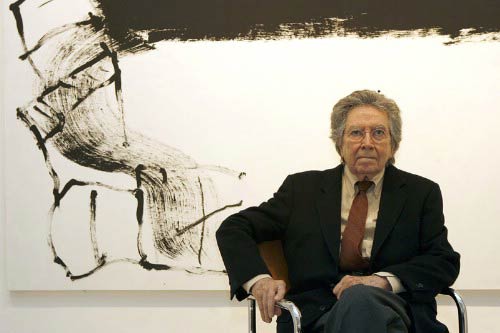| Antoni Tàpies | |
|---|---|
 |
|
| Born | Dec. 13, 1923 Barcelona, Spain |
| Died | Feb. 6, 2012 (at age 88) Barcelona, Spain |
| Nationality | Spanish |
| Movement | Art informel |
| Field | Painting, sculpture, lithography |
| Works | View Complete Works |
The life of Catalan artist Antoni Tàpies was one of political consciousness and innovative art. Arguably one of the most famous artists to come out of the Catalonia regions of Spain, Tàpies perfected his craft by devoting most of his life to the world of art. A master of mixed media, the self-taught artist specialized in creating unique paintings and sculptures that intrigued and provoked while ensuring that his mark was made on contemporary artists that came after him.
Early Years
Born on December 13th, 1923 in Barcelona, Tàpies was the son of a lawyer. Although he studied law for a few years, he was encouraged by his parents to be well versed in the arts and literature. This prompted Tàpies to teach himself how to draw, sculpt and paint. Later, he enrolled in drawing classes which he attended at night and decided that he would abandon law school and become an artist full time. While he was finding his voice in the art world, he often drew inspiration from iconic artists like Pablo Picasso and Vincent Van Gogh.
Style and Technique
As co-founder of Dau al Set, artistic movement formed in 1948, Antoni Tàpies wanted the concepts of conscious and unconscious to be stressed in his artwork. His early works were in the surrealist style and influenced by people like Paul Klee. Unusual concepts, elements and visuals were paired together with the artwork having a philosophical meaning behind it. In the beginning Tàpies drew and painted many self-portraits before graduating to grattage, or a scraping style of creating artwork. One of his early signatures was his paintings of crosses using torn paper or some other unusual medium. Torn strips of newspaper and toilet paper became common and gave his work a larger-than-life feel.
Antoni Tàpies continued to experiment with many different materials and non-art forms. He began to pull away from the surrealist technique to focus on a more abstract style of art that included huge murals and sculptures. This style fused materials such as clay and marble dust to paintings in order to add a richness and texture not widely seen in art thus far. By the 1950s, Tàpies was fully engaged in the Abstract Informel movement that pushed the use of unconventional materials in art.
Famous Works
Tàpies worked feverishly throughout his career, developing unique works like Desk and Straw. In this painting, a lone desk is covered with paper and draws the viewer in to its mass of confusion. He also created Sock in 1971 that was simply a man’s white sock attached to a canvas. The body of his work was vast and continued up to his death in 2012.
The contribution that Antoni Tàpies has made can be seen in the contemporary art movement that is around today. His juxtaposition of everyday items and his use of unconventional material in his painting helped set the stage for modern artists to express through their work. In 2010, he was given the title of Marques de Tàpies by King Juan Carlos and formally recognized as one of the most original artists of all time.